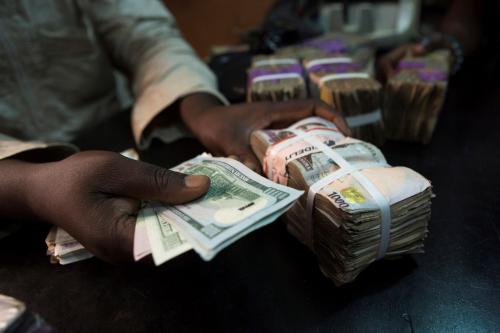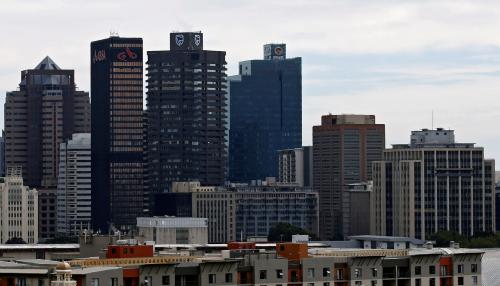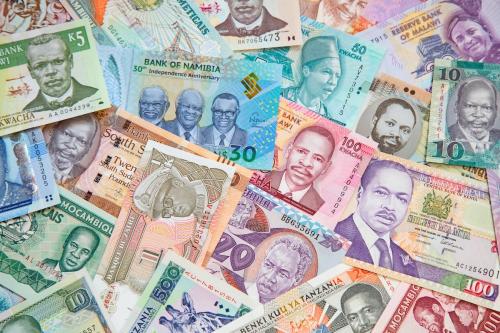Ever since the commodity super cycle associated with rapid Chinese growth ended abruptly in 2014, a drumbeat about another debt crisis in Africa has been in the air. The Economist and The Wall Street Journal have been ringing alarm bells about the rapidly increasing government debt, just years after the debt relief granted between the Heavily Indebted Poor Countries Initiative and Multilateral Debt Relief Initiative (HIPC-MDRI).
Meanwhile, faced with their own debt and political problems, donors have become less keen to provide pure grants. Concessional official development assistance (ODA) from Organization for Economic Cooperation and Development donors fell from $57 billion in 2013 to $51 billion in 2015. Donor pledges are likely to be stagnant or declining in both the recently concluded 14th replenishment for the African Development Fund (ADF-14) and the 18th replenishment for International Development Association (IDA-18); the large increase from IDA-17 is because of proposed market borrowing and higher loan repayments.
Is another debt crisis in the distance?
With concessional finance on the wane in terms of both volumes and interest rates, are we likely to encounter a new debt crisis in Africa? We explored this topic in a recent working paper written for the ADF Policy Innovation Lab, which was tasked with innovating development financing for poorer African countries.
In contrast to the Debt Sustainability Framework (DSF) of the International Monetary Fund and World Bank, which defines debt distress in relation to external debt, public plus private (the bulk of it tends to be public), we focused on public debt sustainability. We did this because the immediate impact of any hardening of donor lending terms will be on public debt dynamics, and because public debt includes the growing amount of domestic borrowing, which is typically on market terms.
For the 33 ADF countries for which data were available, we tried to answer two questions: First, is there evidence of deterioration in public debt dynamics, and, if so, what are the underlying factors? Second, does official funds or market borrowing drive the marginal cost of government debt? To discuss the hypotheses emerging from the desk analysis with senior policymakers, nongovernmental organizations, and think tanks, we visited Côte d’Ivoire, Ghana, Mozambique, Rwanda, and Uganda.
We equated “hardened lending terms” with the introduction of moderately concessional loans. MCLs would be 40-year U.S. dollar denominated loans at 3-4 percent interest (benchmarked on the U.S. 30-year Treasury bill) and 10 years’ grace. We found that switching to MCLs would not exacerbate debt sustainability problems in 17 of the 33 countries we studied, because MCLs would be less costly and of longer maturity than the U.S. dollar eurobonds now being issued. These bonds have yields of 6-12 percent, typically with a maturity of 10 years and a bullet repayment of principal at the end. MCL terms would also be competitive against loans from China or bridge loans from commercial banks, on which we obtained anecdotal information.
We found that the poor use of public funds, including those from natural resources, and insufficient emphasis on public value for money and costly market borrowings are much more important for debt sustainability than the interest rate on the official component of public debt. In addition, exchange rate collapses stemming from poor management of commodity price volatility— accentuated by political instability and corruption—tend to dwarf the official interest rate. In fact, switching to MCLs could actually bolster debt sustainability provided official resources increased enough to displace expensive market borrowing and steps were taken to strengthen governance and growth. A debt crisis in these 17 countries cannot be ruled out—indeed, Mozambique has already defaulted on its debt—but the cause is unlikely to be less concessional ODA.
However, official funds determine the marginal borrowing cost for the remaining 16 countries, many of which are fragile. These countries will still need highly concessional funds, calling for a distinction between countries that can handle MCLs and those that cannot. But even here exchange rate collapses and poor use of public funds play a major role. Indeed, many of these countries are rich in natural resources but have low Country Policy and Institutional Assessment scores, indicating self-inflicted fragility. A debt crisis in these 16 countries is more likely.
Time to take a new look at debt sustainability
This raises a crucial point. The IMF-World Bank DSF tends to look at debt sustainability as an end in itself. This made sense when the DSF was rolled out in 2004 to provide the underpinnings for debt relief via HIPC-MDRI. It has since fallen short because development goals are under-emphasized.
Ghana, which benefited from HIPC-MDRI and then discovered oil, provides a telling illustration. As a result of repeated fiscal slippages and weak public finance management institutions, its public debt has become unsustainable. Surprisingly, the path toward sustainability outlined in the IMF-World Bank October 2016 debt sustainability analysis is based not on solving the country’s fundamental fiscal problems and reinvigorating growth but on gambling on new oil discoveries while issuing Eurobonds to escape soaring borrowing costs in the domestic market. Never mind that concerns abound about the use of public resources and switching to Eurobonds could exacerbate dangerous currency mismatches on the government’s balance sheet. The emphasis has shifted toward fundamentals only in 2017, when serious fiscal lapses were discovered and the 2016 public debt-to-GDP targets were badly missed.
Our findings indicate that Ghana is not unique. Public debt dynamics are likely to remain challenging across the board in Africa. Countries that would benefit from MCLs on marginal borrowing cost grounds would need to up their game considerably to reap development benefits. Indeed, doing so should be considered a precondition for access to MCLs.
Innovative development finance is needed
At the same time, ADF countries need large upfront investments in infrastructure and human capital to raise growth rates, alleviate poverty, and provide jobs for the continent’s youth. Even in the best-managed countries like Kenya, Côte d’Ivoire, Ethiopia, and Rwanda, the tension between the need for large public investments and keeping government debt and external deficits down is palpable. The capital market is unlikely to be a good or stable source of development finance—it is myopic and unforgiving. The costs rise sharply with successive bond issues, demonstrated by the experience of ADF countries that have issued eurobonds. But concessional funding post HIPC-MDRI has delivered neither sustainable public debt profiles nor a stable foundation for sustained growth.
This situation demands a fundamental re-think along two dimensions. First, how should the donor-African country relationship be changed to improve development outcomes? Second, is there scope for innovative financing to provide the sizable funds Africa needs for infrastructure and human capital without increasing the burden on donors? Answers to these questions are explored in our working paper.
The views herein are those of the authors and not necessarily shared by the African Development Bank or the African Development Fund






Commentary
Will less concessional development assistance for Africa cause another debt crisis?
September 21, 2017